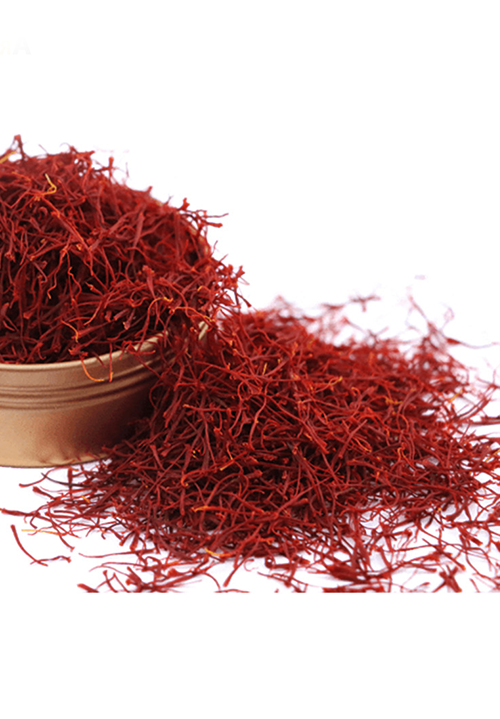Premium Saffron

Saffron is a spice derived from the flower of Crocus sativus, commonly known as the “saffron crocus”. The vivid crimson stigma and styles, called threads, are collected and dried for use mainly as a seasoning and colouring agent in food. Saffron has long been the world’s most costly spice by weight. Although some doubts remain on its origin, it is believed that saffron originated. However, Greece and Mesopotamia have also been suggested as the possible region of origin of this plant: Harold McGee states that it was domesticated in or near Greece during the Bronze Age. C. sativus is possibly a triploid form of Crocus cartwrightianus, which is also known as “wild saffron”. Saffron crocus slowly propagated throughout much of Eurasia and was later brought to parts of North Africa, North America, and Oceania.
Saffron’s taste and iodoform-like or hay-like fragrance result from the phytochemicals picrocrocin and safranal. It also contains a carotenoid pigment, crocin, which imparts a rich golden-yellow hue to dishes and textiles. Its recorded history is attested in a 7th-century BC Assyrian botanical treatise, and has been traded and used for over thousands of years. In the 21st century, produces some 90% of the world total for saffron. At US $5,000 per kg or higher, saffron is the world’s most expensive spice.
Benefits of Saffron
- A Powerful Antioxidant.
- May Improve Mood and Treat Depressive Symptoms.
- May Have Cancer-Fighting Properties.
- May Reduce PMS Symptoms.
- May Act as an Aphrodisiac.
- May Reduce Appetite and Aid Weight Loss.
- Easy to Add to Your Diet.
Types of Saffron
Are you aware of the fact that saffron has been used as a natural remedy for over 90 illnesses for the last four millennia? Today, saffron is mostly used as a unique spice for adding an attractive flavor and aroma to various dishes. Of course, more and more people are showing interest in the medicinal properties of this spice due to the fact that natural treatments are becoming more popular. Saffron is often divided into categories based on the country of origin. Currently, the main producers of Saffron, Afghanistan, Spain and Greece.
Persian saffron is by far the most desired form of Saffron today. In fact, not only was the earliest evidence of Saffron cultivation found in Ancient Persia, but this region of the world accounts for over 90% of the worlds total saffron supply.
Many third party distributors claim that they have the “highest quality saffron in the world” but this is almost always a false advertisement. Luckily for consumers, the quality and potency of Saffron is actually measurable.
The quality of Saffron is measured by conducting a lab analysis of the product, when it comes to testing Saffron there are three main factors to consider. The three most important factors are Safranal, Crocin, and Picocrocin.
- Safranal (Aroma Strength)
| Category 1 average >20-50 |
| International average >20-50 |
| Zaran Saffron average 40-50 |
- Crocin (Coloring Strength)
| Category 1 average >190 |
| International average >230 |
| Zaran Saffron average 260 |
- Picocrocin (Flavor Strength)
| Category 1 average >70 |
| International average >85 |
| Zaran Saffron average 110 |
Classifications of Persian Saffron
What is even more interesting is that there are four main classifications of Persian saffron, these four classifications are based on the trim of the saffron thread. The four different trims of Persian Saffron are:
- Sargol:means “Top of the flower” in Farsi. Sargol is a sub-type of Persian saffron that derives from the very tip of the saffron thread. Hence, its name “top of flower”. It also has a specific, powerful aroma. Generally speaking, Sargol saffron is considered to be high quality due to its lack of Yellow or Orange threads. Sargol can be easily recognized thanks to its full and deep red color and short threads. On the downside, Sargol saffron often contains crumbs and broken threads.
- Super Negin: The most expensive and rare trim of Saffron. Super Negin saffron is known not only for being the most potent but also for its aesthetically pleasing features. Super Negin threads are longer in length and contain no yellow or orange threads. The threads are cut symmetrically and contain no crumbs. When comparing all the trims of Saffron, Super Negin is the most sought after for those who want the best of the best.
- Negin: When compared to Sargol and Super Negin, Negin is longer in length and contains some yellow and orange portions of the thread. To put it in simple words, the aroma, quality, and purity are still great but you do pay for some portions of the yellow and orange threads, which are lower quality.
- Pushal saffron is the cheapest and most commonly sold Saffron trim in stores. Since Saffron is so expensive, many distributors take advantage of consumers by selling them the orange and yellow portions of the thread to increase their profit margins. Since these yellow parts of the stigma contain no value, consumers end up paying much more in reality for a inferior product.
(Learn how to test the quality of your saffron here)
All in all, Persian Saffron will almost always be high quality as long as its purchased through a reputable and trusted source.It will continue to hold a reputation of High Quality Saffron due to its highly suitable features, such as: Climate, Topography, Soil, and Organic Harvesting methods.
Choosing any of these types of Persian saffron is a smart choice, but for those looking for the best of the best – Super Negin it the most expensive and rare form of Saffron. It’s also the highest quality saffron available on the market.

